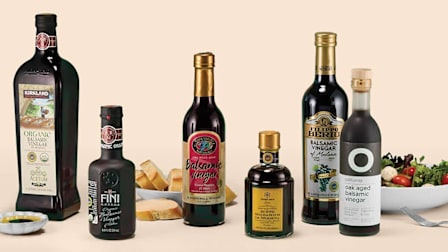Sancocho Stand-Off: Dutch Oven vs. Slow Cooker vs. Multi-Cooker
My mom and abuela told me that the Dutch oven was more authentic, but I needed a faster solution. Could the Instant Pot deliver quick and delicious results?
When you shop through retailer links on our site, we may earn affiliate commissions. 100% of the fees we collect are used to support our nonprofit mission. Learn more.
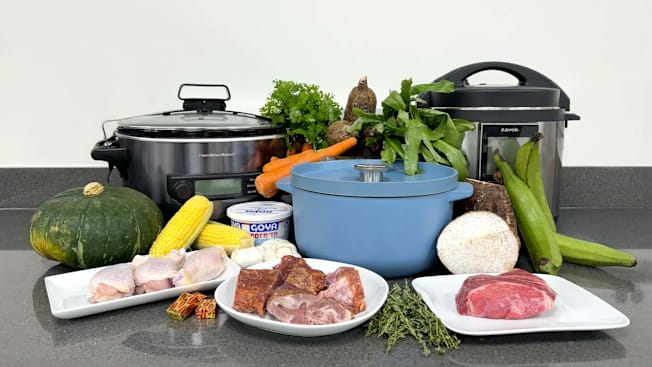
As soon as the weather begins to cool, my mom starts making sancocho—a hearty stew filled with meat and tuber vegetables.
In the sweltering heat of the Dominican Republic, my grandmother still makes sancocho on special occasions, sweating over the stove as she adds every vegetable, meat, and spice in just the right order to the largest pot anyone in the neighborhood is willing to lend for the occasion. One of my favorite ways to eat it is sitting along the riverbank in my parents’ hometown, cooked alongside a giant pot of white rice over an open fire.
What Is in Sancocho?
If you’re like me and you usually pick dinner recipes based on how short the ingredients list is, sancocho can look pretty intimidating. Most recipes require at least three different cuts of meat, plus a long list of vegetables that include plantains, yuca, yam, squash, corn, and more.
For the meat, my mom’s recipe uses pork neck bones, beef short ribs, and chicken drumsticks. Gomez’s recipe uses chicken thighs, beef stew meat, and beef ribs. The recipe on My Dominican Kitchen uses three different cuts of pork. Other recipes can include as many as seven different cuts of meat from goat, pork, chicken, and beef.
All this to say, sancocho is highly customizable. There are no rules for what cuts of meat you use, and the same goes for the root vegetables in the recipe. According to Gomez, there are a few nonnegotiables, though: A sancocho should never have noodles and potatoes are not essential, though some people do add them to their recipes.

What absolutely does belong in a sancocho are root vegetables like yuca, yautía, and plantains. They provide the authentic, hearty foundation of the dish and absorb the broth’s flavors beautifully.
Founder of Floritza's Flavors
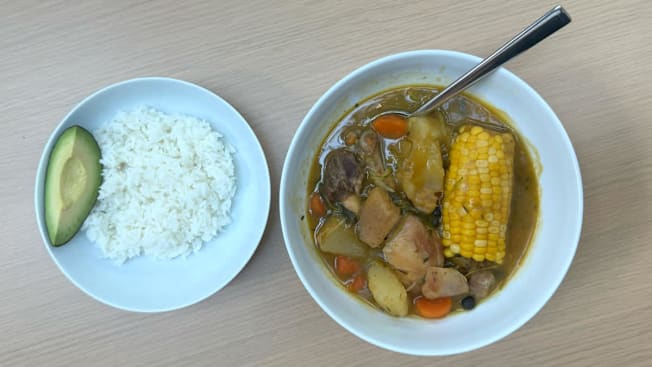
Photo: Consumer Reports Photo: Consumer Reports
Sancocho
Adapted from Floritza Gomez, My Dominican Kitchen, and my mom’s recipes.
Makes 8 to 10 servings.
For Meat Seasoning
1 pound chicken drumsticks
1 pound beef chuck short ribs
½ pound pork neck bones
2 Tbsp. sofrito
1 tsp. adobo/all-purpose seasoning
1 tsp. ground oregano
2-3 Tbsp. vegetable oil
For Stew
2 ears of corn, cut in thirds
1 pound kabocha squash, peeled and cut into chunks
2 green plantains, peeled and sliced
1 pound malanga, peeled and cut into chunks
1 pound yuca, peeled and cut into chunks
1 large carrot, peeled and cut into slices
2 chicken bouillon cubes
6 cups of water (enough to fill the pot about ¾ of the way)
1 tsp. whole allspice
4 whole leaves culantro
2 Tbsp. fresh cilantro leaves
5 sprigs of fresh thyme
Salt and pepper to taste
For Serving
Avocado
Fresh lime juice
Hot sauce
White rice
Directions
- In a large bowl, season chicken drumsticks, beef chuck short ribs, and pork neck bones with sofrito, adobo, and ground oregano. Allow to marinate for 30 minutes to 48 hours.
- In a large pot or Dutch oven (at least 6-quart capacity), heat oil over medium-high heat. When the oil is hot, add the seasoned meat in small batches, searing for about 2 minutes on each side until browned.
- Lower the heat and allow the meat to cook until tender, about 30 minutes. Check the meat periodically to make sure it does not burn. Remove the meat and set aside.
- In the same pot, add all the cut vegetables and 6 cups of water (or enough water to fill the pot ¾ of the way).
- When the water begins to boil, add the chicken bouillon cubes, 1 tsp. of ground oregano, salt, pepper, and whole allspice. Allow the pot to simmer for about 30 minutes, stirring occasionally.
- Check if the kabocha squash is tender. If so, remove it from the pot, add it to a blender with ½ cup of the water from the pot, and blend until smooth. Pour the blended squash back into the pot. If you prefer a lighter stew, skip this step.
- Add the thyme, culantro, and cilantro to the pot. If you prefer not to have large herbs in your finished stew, tie the herbs together with twine so they can be removed before serving.
- Add the cooked meat to the pot and allow the stew to simmer on low heat for another 30 minutes to an hour.
- Serve in a bowl with a fresh squeeze of lime juice and a splash of hot sauce, with a separate bowl of white rice and avocado on the side.
Dutch Oven vs. Slow Cooker vs. Multi-Cooker: Preparation
All three cooking methods require a significant amount of prep work. The vegetables were not the easiest to peel for me, so I spent about 45 minutes peeling and cutting all the veggies necessary for all three cooking methods. If I were to make just one, I’d imagine I would spend 15 to 20 minutes on this step. After the vegetables have been cut and the meat has been seasoned, the rest of the cooking is pretty hands-off.
The recipe above lists the steps required to make sancocho in a Dutch oven.
To adapt this recipe to a slow cooker, you’ll need to dirty one extra piece of cookware to sear the meat before adding it into the slow cooker. The meat should also be added to the stew in the slow cooker earlier in the process—with the vegetables—to ensure that it is completely cooked. I set our slow cooker to high for 6 hours. This isn’t the method you’ll want to try if you’re starting dinner after a full day of work.
To adapt the recipe to a multi-cooker, I used the sauté function to sear and cook the meat before adding all the ingredients (vegetables, seasonings, herbs, meat, and water) into the device. Then I set the multi-cooker to pressure cook on high for 30 minutes. After a half-hour, I allowed the pressure to release naturally for 10 minutes before turning the pressure regulator knob to steam to release the rest of the pressure inside the device.
You Eat With Your Eyes First: How Each Version Looked Before Tasting
Dutch oven: It looked just like the sancocho my mom makes. The broth looked thick, and the meat and veggies seemed perfectly tender. When I was done cooking, I FaceTimed my mom to show her what all three sancochos looked like. She was most impressed with this one.
Slow cooker: This sancocho (pictured below) was significantly lighter than the one made in the Dutch oven (more like a broth than a stew). The vegetables were not as tender, and the meat looked a lot less appetizing, as it had lost most of the sear I gave it before adding it to the slow cooker.
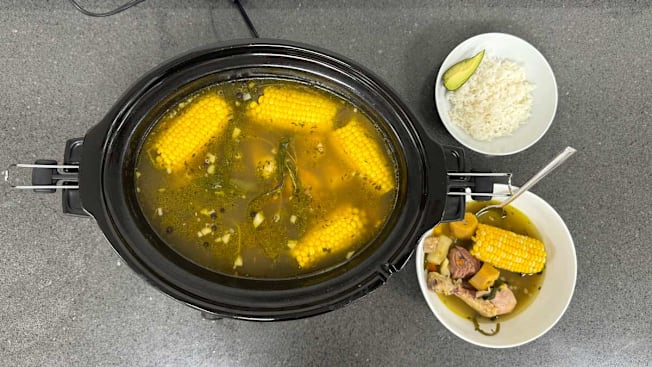
Photo: Consumer Reports Photo: Consumer Reports
Multi-cooker: All the squash dissolved into the stew, so there was no need to remove it, blend it, and add it back into the pot. Most of the meat had melted into the stew too. Meatless drumsticks floated in the stew, and the broth was thick with chunks of meat.
Note: Use caution when opening and closing a multi-cooker. Never try to remove the top of a multi-cooker before allowing all the steam to release from the device. When closing, make sure that the top is firmly locked in place before starting any cooking function.
The Taste Test
I timed the cooking of the three sancochos pretty poorly when I made them. My Dutch oven sancocho was ready to eat by lunchtime, the slow cooker recipe wasn’t done until about 6 p.m., and I started the multi-cooker just before 4 p.m. so most of our tasters weren’t around to taste all three side by side. I refrigerated the three sancochos and reheated them the following day to taste. This likely affected their opinions of the three recipes, though positively so, as sancocho is said to be even tastier when it is reheated (the flavors have more time to develop).
To me, all three methods tasted delicious. They were rich, flavorful, and packed with chunks of meat and vegetables. The difference was in the texture. My favorite was, no surprise, the Dutch oven sancocho (pictured below). It reminded me most of the sancocho I am familiar with at home. I loved the thickness of the broth and that the meat was well-cooked, but didn’t taste like meat that had just been stewed for hours.
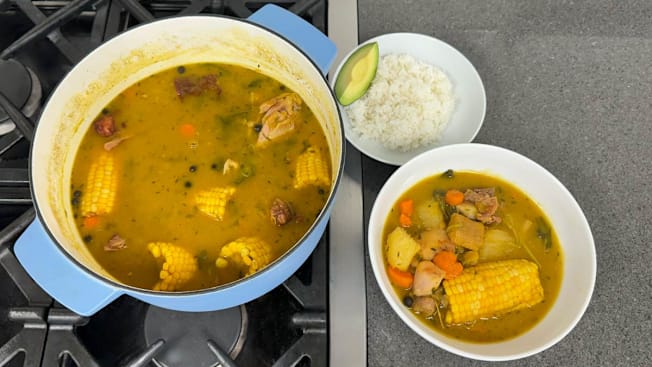
Photo: Consumer Reports Photo: Consumer Reports
The multi-cooker sancocho (pictured below) was my second favorite because though most of the meat had fallen off the bone, I knew it was cooked thoroughly and the vegetables were extremely tender (almost too tender). Coming in last place was the slow cooker sancocho. It wasn’t bad, but the look of the meat was extremely off-putting to me. Though I knew it all had to be well cooked after 6 hours on high, I hated the pale look of the meat and had a hard time eating it. The broth of this sancocho was also significantly lighter than the other two methods—the squash had not thickened it the way it did for the Dutch oven method.
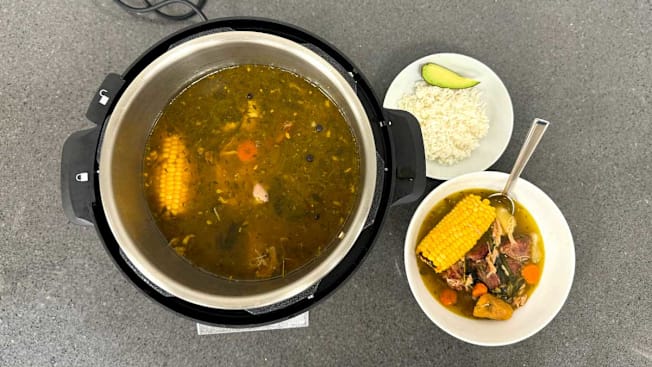
Photo: Consumer Reports Photo: Consumer Reports
Ten taste testers tried each sancocho in side-by-side bowls. Most had never tasted sancocho before, but even those who tried it for the first time agreed that it was a delicious recipe. Seven of them chose the Dutch oven sancocho as their favorite—because of both the flavor and texture. Gomez wasn’t surprised that this method was the fan favorite. She said, “ Sancocho is a slow-cooked, hearty stew that benefits from the consistent temperature and heat retention a Dutch oven offers. This allows the flavors to meld together perfectly, giving the dish a rich, deep flavor. The heavy lid also helps lock in steam, keeping the broth rich and preventing it from evaporating too quickly.”
One tester accustomed to eating Colombian sancocho said he preferred the multi-cooker method because it reminded him most of what he eats at home. One other tester agreed and chose this method as their favorite too. A lone taster preferred the slow cooker method.
At the end of the day, no sancocho was left—not even the least favored slow cooker kind—because people came by with empty food containers to take some home for dinner.


















